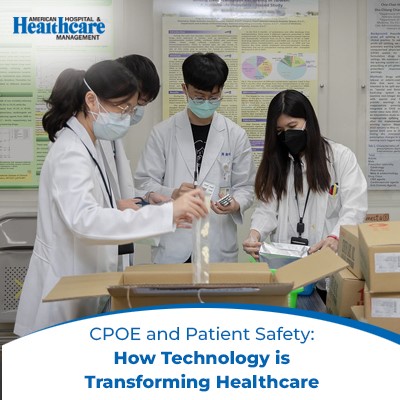CPOE (Computerized Physician Order Entry) is revolutionizing healthcare by enhancing patient safety and efficiency. It reduces medication errors, improves communication, and streamlines processes. Despite challenges like costs and technical issues, its benefits are clear. Future advancements in AI and mobile access promise even greater improvements in patient care.

Computerized Physician Order Entry (CPOE) is changing the way healthcare providers work. This technology allows doctors and nurses to enter treatment instructions directly into a computer system. By using CPOE, hospitals and clinics can improve patient safety, make healthcare processes smoother, and reduce mistakes. This article will explain how CPOE is making healthcare better for everyone.
CPOE stands for Computerized Physician Order Entry. It is a system that lets doctors and other healthcare professionals enter medical orders, like prescriptions and lab tests, into a computer. These orders are then sent directly to the right department. CPOE systems are usually connected to electronic health records (EHRs), which keep all of a patient's health information in one place. This connection makes sure that doctors have the most up-to-date information when making decisions about patient care.
Fewer Medication Mistakes
CPOE systems help reduce medication errors in several ways. First, since doctors enter orders directly into the computer, there are no issues with messy handwriting or misinterpretations. The system ensures that instructions are clear and easy to read. Additionally, CPOE systems provide real-time alerts. For example, if a doctor tries to prescribe a medication that could cause an allergic reaction or interact poorly with another drug the patient is taking, the system will warn them. These alerts help doctors make safer choices and avoid potential problems.
Better Communication
CPOE improves communication within the healthcare team. When orders are entered electronically, they are immediately sent to the correct department, such as the pharmacy or laboratory. This speed ensures that patients get the tests, treatments, and medications they need more quickly. Electronic orders are also standardized and clear, which reduces misunderstandings and errors caused by unclear instructions.
Following Best Practices
CPOE systems can include clinical guidelines and checklists to ensure that patient care follows the latest medical standards. This means doctors are supported in making decisions that align with best practices. Additionally, because all orders are tracked in the system, it is easy to review and audit care processes. This transparency helps healthcare providers identify and correct any issues, continuously improving patient care.
Quick and Easy Ordering
CPOE systems make it easier and faster for doctors to enter medical orders. They provide templates for common orders, so doctors don't have to type everything out each time. This saves time and reduces the chance of errors. Routine tasks, like scheduling follow-up tests or treatments, can also be automated. This automation frees up healthcare workers to spend more time with their patients.
Working with Electronic Health Records (EHRs)
CPOE systems are often linked with electronic health records (EHRs), which store all of a patient's health information in one place. This integration means that doctors always have access to the most current patient information, making it easier to provide consistent and coordinated care. Important data can be shared across different departments, ensuring that everyone involved in a patient's care is on the same page.
Avoiding Redundancies
CPOE systems help prevent unnecessary tests and procedures. If a doctor orders a test that has already been done recently, the system can flag this and prevent duplication. This not only saves time and resources but also spares patients from undergoing unnecessary procedures. By managing resources more efficiently, hospitals can ensure that staff and equipment are used where they are needed most.
Costs
Implementing CPOE systems can be expensive. The initial setup requires investment in computers, software, and training for staff. There are also ongoing costs for maintaining and updating the system. However, many healthcare providers find that the long-term benefits, such as improved patient safety and efficiency, outweigh these initial costs.
Adapting to New Systems
Switching to a CPOE system can be challenging for healthcare workers who are used to traditional methods. Training is essential to ensure that all staff members are comfortable using the new system. Additionally, integrating CPOE into existing workflows can take time and effort. It requires careful planning and support to make the transition as smooth as possible.
Technical Issues
Like any technology, CPOE systems can experience technical problems. It's important to ensure that these systems are reliable and have minimal downtime. Compatibility with older computer systems in hospitals can also be an issue. Sometimes, these older systems need to be updated or replaced to work seamlessly with CPOE.
Smarter Decision Support
As technology advances, CPOE systems are becoming even smarter. Artificial intelligence (AI) can analyze large amounts of data to provide more accurate recommendations and warnings. Machine learning can identify patterns and trends, improving the system's ability to support doctors in making safe decisions.
Mobile Access
Mobile access to CPOE systems allows doctors to enter orders from anywhere, making the system more flexible. This is especially useful for remote healthcare and telemedicine. As telemedicine continues to grow, integrating CPOE with these platforms will be increasingly important.
Involving Patients
CPOE systems can also help engage patients in their own care. Online patient portals allow patients to view their orders and results, helping them stay informed. Collecting patient feedback through these systems can also help healthcare providers continuously improve care processes and outcomes.
CPOE is a powerful tool that is transforming healthcare by improving patient safety, enhancing efficiency, and ensuring that care follows best practices. While there are challenges to implementing and maintaining these systems, the benefits are clear. CPOE helps reduce errors, improve communication, and streamline healthcare processes. As technology continues to advance, CPOE will play an even more important role in delivering high-quality care and better patient outcomes.